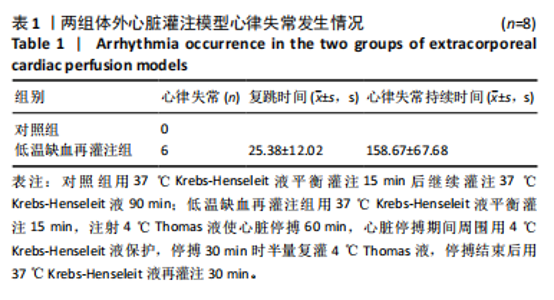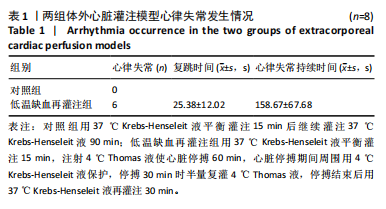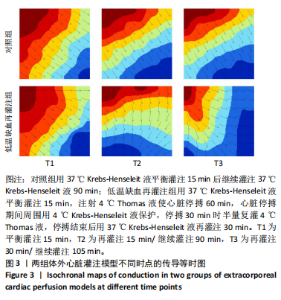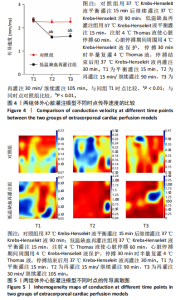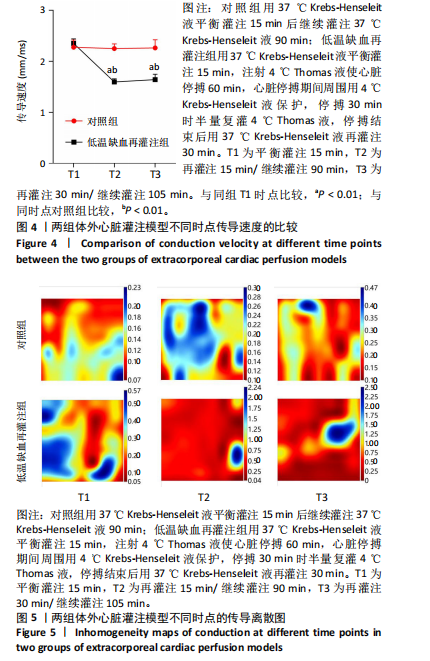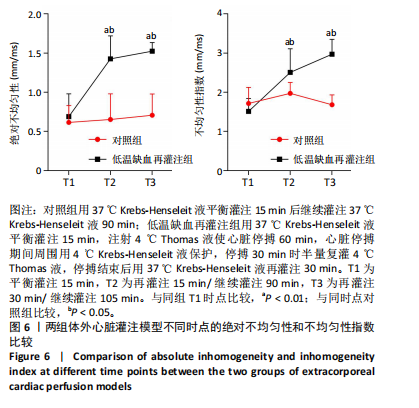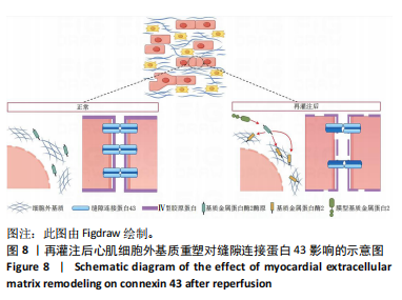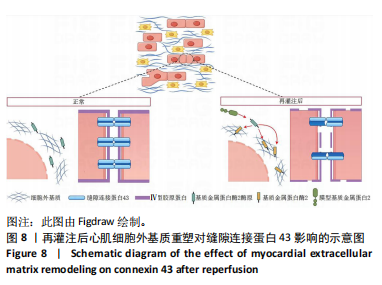Chinese Journal of Tissue Engineering Research ›› 2025, Vol. 29 ›› Issue (29): 6212-6218.doi: 10.12307/2025.775
Previous Articles Next Articles
Effects of myocardial extracellular matrix remodeling on connexin 43 and its Ser368 phosphorylation and electrical conduction
Song Yuting1, Wen Chunlei1, Li Yi1, Bai Xue1, Gao Hong2, Hu Tingju2, Wang Zijun1, Yan Xu1
- 1School of Anesthesiology, Guizhou Medical University, Guiyang 550004, Guizhou Province, China; 2Department of Anesthesiology, Affiliated Hospital of Guizhou Medical University, Guiyang 550004, Guizhou Province, China
-
Received:2024-08-29Accepted:2024-10-31Online:2025-10-18Published:2025-03-06 -
Contact:Gao Hong, Professor, Department of Anesthesiology, Affiliated Hospital of Guizhou Medical University, Guiyang 550004, Guizhou Province, China -
About author:Song Yuting, Master candidate, School of Anesthesiology, Guizhou Medical University, Guiyang 550004, Guizhou Province, China -
Supported by:Guizhou Provincial Science and Technology Project (Natural Science), No. Qiankehejichu ZK[2024] yiban 195 (to GH, WCL, BX, SYT)
CLC Number:
Cite this article
Song Yuting, Wen Chunlei, Li Yi, Bai Xue, Gao Hong, Hu Tingju, Wang Zijun, Yan Xu. Effects of myocardial extracellular matrix remodeling on connexin 43 and its Ser368 phosphorylation and electrical conduction[J]. Chinese Journal of Tissue Engineering Research, 2025, 29(29): 6212-6218.
share this article
Add to citation manager EndNote|Reference Manager|ProCite|BibTeX|RefWorks
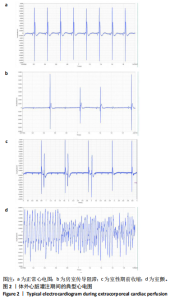
2.3 两组传导速度的比较 为了说明再灌注对心脏电传导的影响,通过采集传导速度和绘制传导等时图检测两组体外心脏在同一时点或同组不同时点的传导差异,以便将传导的差异进行量化及可视化。对照组和低温缺血再灌注组不同时间点的传导等时图,见图3。对照组T1、T2和T3时点的传导等时图均匀且方向规律,T2和T3时点的传导速度与T1时点比较无差异(P > 0.05);低温缺血再灌注组T2和T3时点的传导等时图不均匀且方向不规律,传导速度慢于T1时点(P < 0.01);低温缺血再灌注组T2和T3时点的传导速度慢于对照组(P < 0.01),见图4。 2.4 两组传导离散度的比较 作为心律失常的另一重要表现,传导离散度可用来评估折返性心律失常的易感性。对照组和低温缺血再灌注组不同时点的传导离散图,见图5。实验结果所示,对照组T1、T2和T3时点的最大局部相位差值变化不大,T2、T3时点的绝对不均匀性和不均匀性指数与T1时点相比无差异(P > 0.05);低温缺血再灌注组T2和T3时点的最大局部相位差值大于T1时点,绝对不均匀性和不均匀性指数大于T1时点(P < 0.01);与对照组相比,缺血再灌注后低温缺血再灌注组T2、T3时点的绝对不均匀性和不均匀性指数均大于对照组(P < 0.05),见图6。 2.5 两组心肌免疫印迹检测结果 免疫印迹检测结果显示,与对照组比较,低温缺血再灌注组膜型基质金属蛋白酶2和基质金属蛋白酶2的蛋白表达增加(P < 0.05或P < 0.01),Ⅳ型胶原蛋白、缝隙连接蛋白43和丝氨酸368位点磷酸化缝隙连接蛋白43的蛋白表达减少(P < 0.05或P < 0.01),见图7。 2.6 再灌注后心肌细胞外基质重塑对缝隙连接蛋白43影响的示意图 基质金属蛋白酶2以酶原的形式存在于细胞外基质中,在生理或病理情况下受到激活后可介导细胞外基质的重塑,见图8。低温缺血再灌注后,由膜型基质金属蛋白酶2激活基质金属蛋白酶2引起Ⅳ型胶原蛋白降解相关的心肌细胞外基质重塑,可能导致缝隙连接蛋白43及有功能的丝氨酸368位点磷酸化缝隙连接蛋白43的蛋白表达减少。"

| [1] WHITTAKER A, ABOUGHDIR M, MAHBUB S, et al. Myocardial protection in cardiac surgery: how limited are the options? A comprehensive literature review. Perfusion. 2021;36(4):338-351. [2] MA YY, CAO Y, GAO H, et al. Sevoflurane Improves Ventricular Conduction by Exosomes Derived from Rat Cardiac Fibroblasts After Hypothermic Global Ischemia-Reperfusion Injury. Drug Des Devel Ther. 2023;17:1719-1732. [3] SHARMA AK, SINGH S, BHAT M, et al. New drug discovery of cardiac anti-arrhythmic drugs: insights in animal models. Sci Rep. 2023; 13(1):16420. [4] KWEK XY, HALL AR, LIM WW, et al. Role of cardiac mitofusins in cardiac conduction following simulated ischemia-reperfusion. Sci Rep. 2022;12(1):21049. [5] UPADHYAY RK, KUMAR K, VISHWAKARMA VK, et al. Delineating the NOX-Mediated Promising Therapeutic Strategies for the Management of Various Cardiovascular Disorders: A Comprehensive Review. Curr Vasc Pharmacol. 2024. doi: 10.2174/0115701611308870240910115023. [6] YANG F, ZHANG XL, LIU HH, et al. Post translational modifications of connexin 43 in ventricular arrhythmias after myocardial infarction. Mol Biol Rep. 2024; 51(1):329. [7] DHEIN S, SALAMEH A. Remodeling of Cardiac Gap Junctional Cell-Cell Coupling. Cells. 2021;10(9):2422. [8] 王贵龙,糜睿,徐雄坤,等.七氟醚对低温全心缺血-再灌注心脏电传导及Cx43 Ser368磷酸化的影响[J]. 临床麻醉学杂志,2020,36(12):1216-1220. [9] 任文鑫,马艺宸,高鸿,等.电针后处理对大鼠缺血再灌注心室肌电传导和缝隙连接蛋白43表达的影响[J].针灸临床杂志,2023,39(2):81-85. [10] YANG H, BORG TK, SCHMIDT LP, et al. Laser cell-micropatterned pair of cardiomyocytes: the relationship between basement membrane development and gap junction maturation. Biofabrication. 2014;6(4):45003. [11] VO HVT, NGUYEN YT, KIM N, et al. Vitamin A, D, E, and K as Matrix Metalloproteinase-2/9 Regulators That Affect Expression and Enzymatic Activity. Int J Mol Sci. 2023;24(23):17038. [12] ITOH Y. Membrane-type matrix metalloproteinases: Their functions and regulations. Matrix Biol. 2015;44-46:207-223. [13] IMOTO K, HIRAKAWA M, OKADA M, et al. Canstatin modulates L-type calcium channel activity in rat ventricular cardiomyocytes. Biochem Biophys Res Commun. 2018;499(4):954-959. [14] OKADA M, YAMAWAKI H. A current perspective of canstatin, a fragment of type IV collagen alpha 2 chain. J Pharmacol Sci. 2019;139(2):59-64. [15] 安丽,高鸿,刘艳秋,等.应激诱导磷蛋白1可能通过调节Cx43表达影响低温缺血再灌注后心室肌电传导[J].实用医学杂志,2023,39(1):35-40. [16] BAARK F, WATERS E, EYKYN TR, et al. Characterization and Validation of Radiotracer Kinetics Using the Langendorff Isolated Perfused Heart. Methods Mol Biol. 2024;2729:251-267. [17] HAN B, TREW ML, ZGIERSKI-JOHNSTON CM. Cardiac Conduction Velocity, Remodeling and Arrhythmogenesis. Cells. 2021;10(11):2923. [18] LEYBAERT L, DE SMET MA, LISSONI A, et al. Connexin hemichannels as candidate targets for cardioprotective and anti-arrhythmic treatments. J Clin Invest. 2023; 133(6):e168117. [19] CAO Y, SONG YN, WANG ZJ, et al. Effects of different dosages esketamine on cardiac conduction and heterogeneity of Cx43: the epicardial mapping in guinea pigs. Ann Transl Med. 2022;10(14):772. [20] VAN RIJEN HV, ECKARDT D, DEGEN J, et al. Slow conduction and enhanced anisotropy increase the propensity for ventricular tachyarrhythmias in adult mice with induced deletion of connexin43. Circulation. 2004;109(8):1048-1055. [21] LIM S, MANGALA MM, HOLLIDAY M, et al. Reduced connexin-43 expression, slow conduction and repolarisation dispersion in a model of hypertrophic cardiomyopathy. Dis Model Mech. 2024;17(8):dmm050407. [22] QU Z, WEISS JN. Cardiac Alternans: From Bedside to Bench and Back. Circ Res. 2023;132(1):127-149. [23] DONG X, TSE G, HAO G, et al. Heterogeneities in Ventricular Conduction Following Treatment with Heptanol: A Multi-Electrode Array Study in Langendorff-Perfused Mouse Hearts. Life (Basel). 2022;12(7):996. [24] GUO YH, YANG YQ. Atrial Fibrillation: Focus on Myocardial Connexins and Gap Junctions. Biology (Basel). 2022;11(4):489. [25] WANG YJ, LI QH, TAO B, et al. Fibroblasts in heart scar tissue directly regulate cardiac excitability and arrhythmogenesis. Science. 2023; 381(6665):1480-1487. [26] JI J, REN X, ZORLUTUNA P. Cardiac Cell Patterning on Customized Microelectrode Arrays for Electrophysiological Recordings. Micromachines (Basel). 2021;12(11): 1351. [27] LEIVADITIS V, MULITA F, DAHM M, et al. History of the development of isolated heart perfusion experimental model and its pioneering role in understanding heart physiology. Arch Med Sci Atheroscler Dis. 2024;9(1):109-121. [28] BOSE A, TRUONG QA, SINGH JP. Biomarkers in electrophysiology: role in arrhythmias and resynchronization therapy. J Interv Card Electrophysiol. 2015; 43(1):31-44. [29] PLAISIER E, GRIBOUVAL O, ALAMOWITCH S, et al. COL4A1 mutations and hereditary angiopathy, nephropathy, aneurysms, and muscle cramps. N Engl J Med. 2007;357(26):2687-2695. [30] SUGIYAMA A, SHIMIZU Y, OKADA M, et al. Preventive Effect of Canstatin against Ventricular Arrhythmia Induced by Ischemia/Reperfusion Injury: A Pilot Study. Int J Mol Sci. 2021;22(3):1004. [31] FANA XZ, ZHU HJ, WU X, et al. Effects of doxycycline on cx43 distribution and cardiac arrhythmia susceptibility of rats after myocardial infarction. Iran J Pharm Res. 2014;13(2):613-621. [32] LI JF, LEVIN MD, XIONG YM, et al. N-cadherin haploinsufficiency affects cardiac gap junctions and arrhythmic susceptibility. J Mol Cell Cardiol. 2008;44(3):597-606. [33] CAO J, GAO Q, CHEN H, et al. Desmin Correlated with Cx43 May Facilitate Intercellular Electrical Coupling during Chronic Heart Failure. Evid Based Complement Alternat Med. 2021;2021(1):6621132. [34] PRUNSKAITE-HYYRYLAINEN R, SHAN JD, RAILO A, et al. Wnt4, a pleiotropic signal for controlling cell polarity, basement membrane integrity, and antimullerian hormone expression during oocyte maturation in the female follicle. FASEB J. 2014;28(4):1568-1581. [35] ZHOU P, YANG XL, YANG DZ, et al. Integrin-Linked Kinase Activation Prevents Ventricular Arrhythmias Induced by Ischemia/Reperfusion Via Inhibition of Connexin 43 Remodeling. J Cardiovasc Transl Res. 2021;14(4):610-618. [36] LV JY, FU ZY, ZHENG HR, et al. Global research trends and emerging opportunities for integrin adhesion complexes in cardiac repair: a scientometric analysis. Front Cardiovasc Med. 2024;11:1308763. [37] MIAO LJ, LU YY, NUSRAT A, et al. beta1 integrins regulate cellular behavior and cardiomyocyte organization during ventricular wall formation. Cardiovasc Res. 2024;120(11):1279-1294. [38] PANG XC, HE X, QIU ZW, et al. Targeting integrin pathways: mechanisms and advances in therapy. Signal Transduct Target Ther. 2023;8(1):1. [39] AI X, YAN JJ, POGWIZD SM. Serine-threonine protein phosphatase regulation of Cx43 dephosphorylation in arrhythmogenic disorders. Cell Signal. 2021;86:110070. [40] NERGER BA, SINHA S, LEE NN, et al. 3D Hydrogel Encapsulation Regulates Nephrogenesis in Kidney Organoids. Adv Mater. 2024;36(14):e2308325. [41] LEWIS-ISRAELI YR, WASSERMAN AH, GABALSKI MA, et al. Self-assembling human heart organoids for the modeling of cardiac development and congenital heart disease. Nat Commun. 2021;12(1):5142. [42] BAI L, LI MM, SU JC. 432A perspective on light-based bioprinting of DNA hydrogels for advanced bone regeneration: Implication for bone organoids. Int J Bioprint. 2023;9(2):688. [43] LI WX, ZHOU ZH, ZHOU XY, et al. 3D Biomimetic Models to Reconstitute Tumor Microenvironment In Vitro: Spheroids, Organoids, and Tumor-on-a-Chip. Adv Healthc Mater. 2023;12(18):e2202609. [44] ZHANG LH, LI T, YU Y, et al. An injectable conductive hydrogel restores electrical transmission at myocardial infarct site to preserve cardiac function and enhance repair. Bioact Mater. 2023;20:339-354. [45] IOAKEIMIDIS NS, PITSIS A, ZEGKOS T, et al. Periostin is overexpressed, correlated with fibrosis and differs among grades of cardiomyocyte hypertrophy in myectomy tissue of patients with hypertrophic cardiomyopathy. PLoS One. 2023; 18(11):e293427. [46] ZHAO S, HULSURKAR MM, LAHIRI SK, et al. Atrial proteomic profiling reveals a switch towards profibrotic gene expression program in CREM-IbDeltaC-X mice with persistent atrial fibrillation. J Mol Cell Cardiol. 2024;190:1-12. |
| [1] | Lai Pengyu, Liang Ran, Shen Shan. Tissue engineering technology for repairing temporomandibular joint: problems and challenges [J]. Chinese Journal of Tissue Engineering Research, 2025, 29(在线): 1-9. |
| [2] | Shui Jing, He Yu, Jiang Nan, Xu Kun, Song Lijuan, Ding Zhibin, Ma Cungen, Li Xinyi. Astrocytes regulate remyelination in central nervous system [J]. Chinese Journal of Tissue Engineering Research, 2025, 29(36): 7889-7897. |
| [3] | Zhang Xiaoyu, Wei Shanwen, Fang Jiawei, Ni Li. Prussian blue nanoparticles restore mitochondrial function in nucleus pulposus cells through antioxidation [J]. Chinese Journal of Tissue Engineering Research, 2025, 29(34): 7318-7325. |
| [4] | Zhou Ying, Tian Yong, Zhong Zhimei, Gu Yongxiang, Fang Hao. Inhibition of tumor necrosis factor receptor associated factor 6 regulates mTORC1/ULK1 signaling and promotes autophagy to improve myocardial injury in sepsis mice [J]. Chinese Journal of Tissue Engineering Research, 2025, 29(30): 6434-6440. |
| [5] | Wang Wanchun, , Yi Jun, Yan Zhangren, Yang Yue, Dong Degang, Li Yumei. 717 Jiedu Decoction remodels homeostasis of extracellular matrix and promotes repair of local injured tissues in rats after Agkistrodon halys bite [J]. Chinese Journal of Tissue Engineering Research, 2025, 29(30): 6457-6465. |
| [6] | Zhang Songjiang, Li Longyang, Zhou Chunguang, Gao Jianfeng. Central anti-inflammatory effect and mechanism of tea polyphenols in exercise fatigue model mice [J]. Chinese Journal of Tissue Engineering Research, 2025, 29(30): 6474-6481. |
| [7] | Wu Xiaochou, Wang Huiying, Wang Jie, Zhang Caifeng, Hou Yanyun, Jin Bo. Protective mechanism of tanshinone IIA in mouse ovarian cryopreservation [J]. Chinese Journal of Tissue Engineering Research, 2025, 29(29): 6198-6204. |
| [8] | Liu Ruojing, Zhao Xue, Zhu Yizhen, Fu Lingling, Zhu Junde. Ginsenoside Rb1 alleviates cerebral ischemic injury in mice by regulating microglial polarization [J]. Chinese Journal of Tissue Engineering Research, 2025, 29(29): 6219-6227. |
| [9] | Sun Rongyan, Xu Luchun, Jiang Guozheng, Song Jiawei, Ma Yukun, Fan Jiaojiao, Wang Guanlong, Yang Yongdong, Yu Xing. Du Meridian electroacupuncture inhibits ferroptosis and promotes neurorepair in rats with acute cervical spinal cord injury [J]. Chinese Journal of Tissue Engineering Research, 2025, 29(29): 6228-6238. |
| [10] | Chen Lijuan, Gao Xinxue, Wu Jin, Du Ying, Lyu Meijun, Sui Guoyuan, Jia Lianqun, Pan Guowei. Construction and evaluation of spleen-deficiency hyperlipidemia mouse models [J]. Chinese Journal of Tissue Engineering Research, 2025, 29(29): 6237-6242. |
| [11] | Du Juan, Zhang Yi, Hao Quanshui. Effects of exercise on activation of microglia and astrocytes and neuronal apoptosis in depressed rats [J]. Chinese Journal of Tissue Engineering Research, 2025, 29(29): 6243-6248. |
| [12] | Liu Haowei, Tian Haodong, Huang Li, Yu Hanglin, Peng Li. Acute effects of blood flow restriction resistance exercise on serum metabolites in obese young men [J]. Chinese Journal of Tissue Engineering Research, 2025, 29(29): 6249-6259. |
| [13] | Zhang Ziyu, Chen Longhao, Sheng Wei, Lyu Hanzhe, Shen Ying, Wang Binghao, Lyu Zhizhen, Lyu Lijiang. Application of artificial intelligence in the diagnosis and treatment of lumbar disc herniation: evolution towards standardization, efficiency, and precision of diagnosis and treatment methods [J]. Chinese Journal of Tissue Engineering Research, 2025, 29(29): 6269-6276. |
| [14] | Sun Yahui, Wang Yufeng, Guo Chao, Yao Junjie, Ji Yuanyuan, Li Zhongxu, Lou Huijuan, Jiang Jinglei, Sun Yiping, Xu Jing, Cong Deyu. Effect of massage on extracellular matrix collagen deposition in skeletal muscle of type 2 diabetic rats [J]. Chinese Journal of Tissue Engineering Research, 2025, 29(26): 5549-5555. |
| [15] | Ji Yaqiong, Ning Zhongping. Protective effect of paeoniflorin on angiotensin II-induced fibrosis in cardiac fibroblasts [J]. Chinese Journal of Tissue Engineering Research, 2025, 29(25): 5382-5389. |
| Viewed | ||||||
|
Full text |
|
|||||
|
Abstract |
|
|||||
